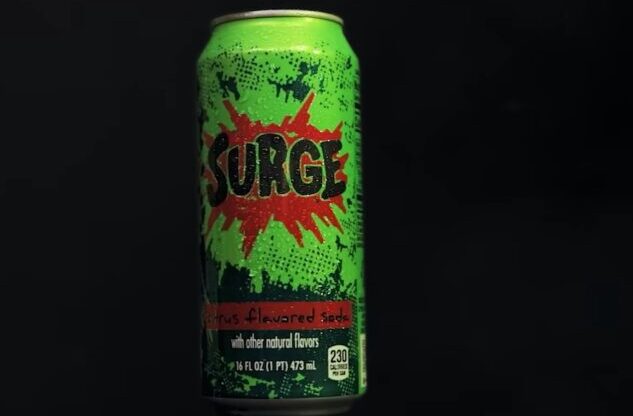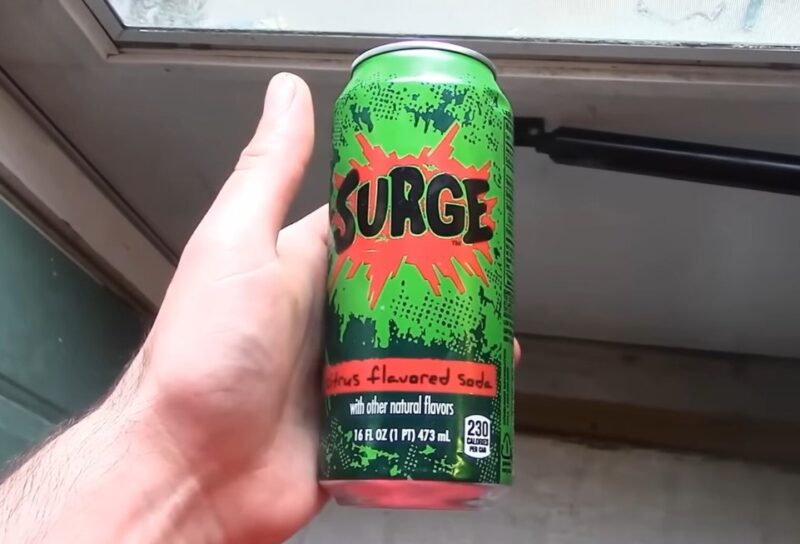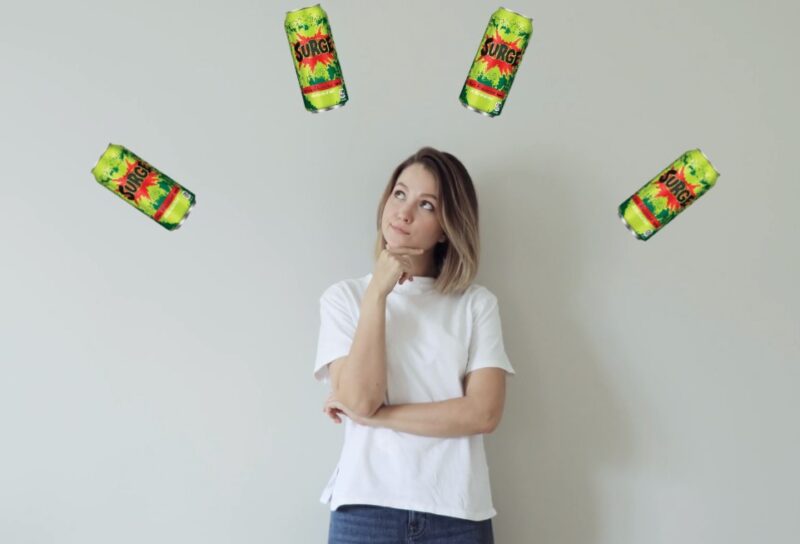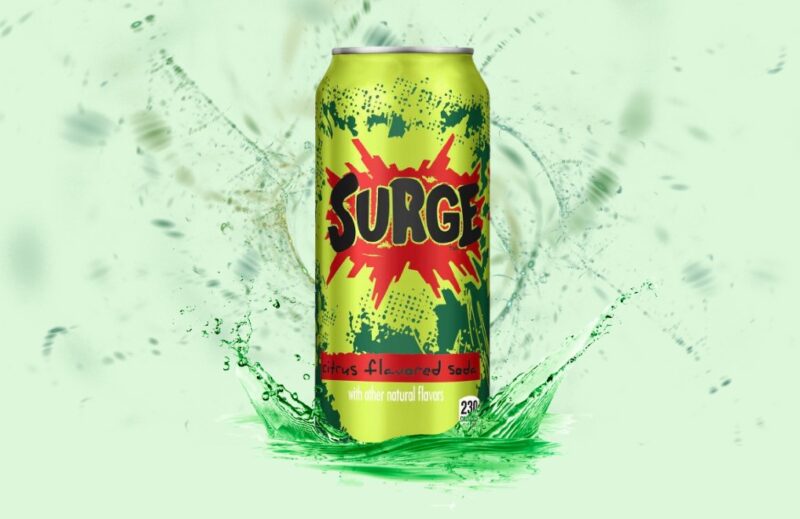In the effervescent world of soft drinks, few have made as big a splash and then vanished beneath the waves quite like Surge Soda. Introduced by Coca-Cola in 1997, this citrus-flavored, caffeine-packed beverage was the epitome of 90s “extreme” culture.
With its vibrant green hue and commercials featuring adrenaline-pumping extreme sports and edgy musicians, Surge was the drink of choice for many a teenager. Yet, by 2003, it had all but disappeared from store shelves.
So, what happened?
The Rise of Surge
In the late 1990s, the soft drink landscape was dominated by familiar names, but there was a bubbling undercurrent of change. Enter Surge, Coca-Cola’s vibrant green answer to Pepsi’s Mountain Dew.
But Surge wasn’t just another soda; it was a statement.
A Response to Competition
Mountain Dew had carved a niche for itself, appealing to the younger generation with its citrusy flavor and energetic branding. Coca-Cola, not one to be left behind, introduced Surge as a direct competitor. But Surge wasn’t merely a copy; it had its own distinct character.
Branding as a Lifestyle
Surge wasn’t just marketed as a drink; it was a lifestyle choice. Its branding was edgy, rebellious, and resonated with the youth’s desire to break free from the norm.
The drink became synonymous with energy, adventure, and the audacity of youth. Its commercials, filled with extreme sports and high-octane activities, further solidified its image as the drink for those who dared to be different.
The Allure of the Forbidden
Interestingly, Surge’s high caffeine content, which led to its ban in several schools, only added to its mystique. For many teenagers, sipping on Surge became an act of rebellion, a small way to push back against the rules.
The Fall of a Titan

As the calendar pages turned to the 2000s, Surge’s meteoric rise began to wane. Several factors contributed to its decline:
1. The Health Trend
With the dawn of the new millennium, there was a palpable shift in consumer behavior. The world was becoming more health-conscious.
Organic, natural, and low-calorie became buzzwords. In this changing landscape, drinks like Vitaminwater and Powerade, which promised hydration with health benefits, became the new favorites.
Surge, with its neon green color, high sugar, and caffeine content, began to look more like a relic of the past than the drink of the future.
2. Negative Publicity
The early 2000s were also a time when the internet was becoming a household staple. Information, true or false, spreads like wildfire. Surge became the subject of various health-related rumors.
Tales of the drink causing headaches, heart palpitations, and other health issues began to circulate. Whether these stories had any basis in reality or were just urban legends, they tarnished Surge’s image, making many consumers think twice before picking up a can.
3. A Crowded Market
The soft drink industry has always been fiercely competitive. The late 90s and early 2000s saw an explosion of new products.
From new flavors to entirely new categories of beverages, the choices were endless. Coca-Cola and Pepsi, in their bid to outdo each other, flooded the market with a variety of drinks. In this deluge, Surge found it challenging to maintain its distinct identity. It became harder and harder for Surge to stand out in the crowded aisles of supermarkets.
International Versions of Surge
Did Surge have counterparts outside the U.S.? Indeed, Surge wasn’t just a sensation in America.
It had a sibling named Urge that made its debut in Scandinavia, specifically a year prior to Surge’s introduction. Notably, the Norwegian rendition of the drink presented a less neon appearance compared to its American counterpart.
However, what it might have lacked in vibrancy, it made up for in popularity, becoming a beloved beverage overseas.
The Cult of Surge

In the annals of soft drink history, few beverages have inspired the kind of fervent devotion that Surge has. Even after its disappearance from the mainstream market, Surge’s spirit lived on, thanks to its die-hard fans.
A Digital Sanctuary
The internet became a haven for Surge enthusiasts. Online forums, websites, and social media groups dedicated solely to Surge began to emerge.
These platforms became a space for fans to reminisce about the good old days, share their most treasured Surge-related memories, and even trade rare merchandise. Some particularly dedicated fans went as far as to experiment in their kitchens, trying to recreate the iconic Surge flavor from scratch.
A Brief Resurgence
Coca-Cola, recognizing the undying love for Surge, decided to give fans a treat. In 2014, they re-released a limited batch of Surge.
The announcement sent waves of excitement across the Surge community. The release was met with such enthusiasm that stocks vanished almost as soon as they appeared.
Fans hoarded cans, some even traveling great distances just to get their hands on a few. But, as with many good things, this revival was fleeting, and Surge once again retreated to the shadows.
What Lies Ahead for Surge?

The tale of Surge is far from over. Several factors indicate that there might be a new chapter waiting to be written.
Nostalgia’s Power
Nostalgia is a potent force. As the children of the 90s mature into adults, there’s a growing desire to revisit the icons of their youth.
This sentiment, combined with the current trend of resurrecting beloved brands from the past, could pave the way for a Surge comeback. After all, who wouldn’t want to relive their carefree days with a can of their favorite drink in hand?
A Passionate Online Community
The Surge community online is not just active; it’s vibrant and passionate. Their continuous efforts to keep the Surge legacy alive could be instrumental in any potential revival.
Petitions, campaigns, and even fan events could generate enough buzz to catch the attention of the decision-makers at Coca-Cola.
The Energy Drink Market
The beverage industry has seen a significant shift towards energy drinks. Brands like Monster, Red Bull, and Rockstar dominate the shelves. Surge, with its high caffeine content, could potentially rebrand itself as an energy drink.
It would cater to those looking for a boost but with the added appeal of nostalgia. This fusion of the past and present could be the perfect recipe for Surge’s triumphant return.
FAQ
When was Surge discontinued?
Surge was discontinued in 2003. However, it made a comeback in various forms, including as a slushy and a limited online run.
Is Surge available today?
Yes, Surge has made a comeback and can be found at several Burger King locations and on Amazon.
What was the public’s perception of Surge?
Surge was known for its loud and daring nature, similar to a friend who never backs down from a dare. It was also known for its bright and syrupy appearance, which was in contrast to the transparent drinks trend of the time.
Were there any myths associated with Surge?
There were myths suggesting that Surge, along with Mountain Dew, had the ability to lower one’s sperm count, though this was not substantiated.
Final Words
The trajectory of Surge Soda, from a cultural emblem to a bygone relic, echoes the dynamic tide of consumer tastes, somewhat akin to the unexpected pairing of Coca-Cola with peanuts. Despite hurdles, the enduring zeal of its aficionados hints that Surge may have an encore awaiting its cue.
As the sands of time trickle, only they will unveil if this once-cherished fizzy delight can surge back into the tapestry of our lives.
